M60 Patton
|
||||||||||||||||||||||||||||||||||||||||||||||||||||||||||
|
||||||||||||||||||||||||||||||||||||||||||||||||||||||||||
|
||||||||||||||||||||||||||||||||||||||||||||||||||||||||||
|
||||||||||||||||||||||||||||||||||||||||||||||||||||||||||
The M60 Series is a second-generation main battle tank (MBT)[2] introduced in December 1960.[3] It was widely used by the U.S. and its Cold War allies, especially those in NATO, and remains in service throughout the world today despite being superseded by the M1 Abrams. Egypt is currently the largest operator with 1,700 upgraded M60A3s, Turkey is second with more than 900 upgraded units in service, and Israel is third with over 700 units of Israeli variants.
Contents |
Nomenclature
Although developed from the M48 Patton, another interim until replaced by the M60, the M60 series was never officially classified as a Patton tank, but as a "product improved descendant" of the Patton series of tanks.[4] On 16 March 1959, the OTCM (Ordnance Technical Committee Minutes) #37002 standardized the vehicle as the 105 mm Gun Full Tracked Combat Tank M60.[5] With the US Army's deactivation of their last (M103) heavy tank battalion, the M60 became the Army's first main battle tank[6] during the Cold War.
M60
The M60 traces its roots to the late WWII-era M26 Pershing heavy tank from which the M48 was developed. In 1957, plans were laid in the US for a tank with a 105 mm main gun and a redesigned hull offering better armor protection.
The resulting M60 series largely resembles the M48 it was based on, but has significant differences. The M60 mounted a bore evacuated 105 mm main gun, compared with the M48's 90 mm, had a hull with a straight front slope where as the M48's hull was rounded, had three support rollers per side to the M48's five, and had road wheels constructed from aluminum rather than steel.
The improved design incorporated a Continental V-12 750 hp air-cooled, twin-turbocharged diesel engine, extending operational range to over 300 miles (480 km) while reducing both refueling and servicing. Power was transmitted to a final drive through a cross drive transmission, a combined transmission, differential, steering, and braking unit.
The hull of the M60 was a single piece steel casting divided into three compartments, with the driver in front, fighting compartment in the middle and engine at the rear.[7] The driver looked through three M27 day periscopes, one of which could be replaced by a night vision periscope.[7] Initially, the M60 had essentially the same turret shape as the M48, but this was subsequently replaced with a distinctive "needlenose" design that minimized frontal cross-section to enemy fire.
The M60 was the last U.S. main battle tank to utilize homogeneous steel armor for protection. It was also the last to feature the M60 machine gun and an escape hatch under the hull.
Originally designated the M68, the new vehicle was put into production in 1959, reclassified as the M60, and entered service in 1960. Over 15,000 M60s (all variants) were constructed.
M60A1

In 1963, the M60 was upgraded to the M60A1. This new variant, which stayed in production until 1980, featured a larger, better-shaped turret and improvements to the armor protection and shock absorbers. The M60A1 was also equipped with a stabilization system for the main gun. However, the M60A1 was still not able to fire on the move, as the system only kept the gun pointed in the same general direction while the tank was traveling cross country. It did however enable the coaxial machine gun to be brought to bear while moving.
M60A2 'Starship'
The M60A2, nicknamed the "Starship" due to its Space Age technology, featured an entirely new low-profile turret with a commander's machine-gun cupola on top, giving the commander a good view and field of fire while under armor but spoiling the low profile. It also featured a 152 mm main gun similar to that of the M551 Sheridan light tank, which fired conventional rounds as well as the Shillelagh anti-tank guided missile (ATGM). The fitting of a CBSS (closed breech scavenger system), which used pressurized air to clear the breech after each shot, solved the problem of unburnt propellant from the main gun rounds fouling the barrel and pre-detonating subsequent rounds. The M60A2 proved a disappointment, though technical advancements would pave the way for future tanks. The Shillelagh/M60A2 system was phased out from active units by 1981, and the turrets scrapped. Most of the M60A2 tanks were rebuilt as M60A3, or the hulls converted to armored vehicle-launched bridge (AVLB) vehicles.[8]
M60A3 Series

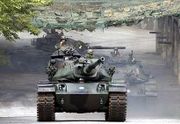
In 1978, work began on the M60A3 variant. It featured a number of technological enhancements, including smoke dischargers, a new rangefinder, and M21 ballistic computer, and a turret stabilization system. All active American M60s eventually underwent the conversion to the A3 model.
The M60A3 was phased out of US service in 1997,[9] but it remained a front-line MBT into the 21st century for a number of other countries.
While overall a considerably less effective tank than the M1 Abrams, the M60A3 did have some limited advantages over some M1 models:
- The M60A3 had a notably better thermal imaging system than that of the M1 up into the 21st Century, when many M1s had newer ones installed. It was, however, considerably noisier, emitting a loud clicking sound audible several meters outside the vehicle.
- The M60A3 had an exterior phone for infantry to talk directly to the crew inside. This feature was also installed on some USMC M1A1s in Iraq and is now being incorporated into all active Abrams.
- The diesel had lower performance, but also had lower cost, maintenance and better fuel efficiency.
- The exhaust temperature of an M1's turbine is very high, which makes it dangerous for infantry to take cover behind it, rather than the diesel engine on an M60A3.
- The escape hatch located under the hull of the M60A3 is not present in the M1 Abrams, making it more difficult for the crew to bail out of a battle-damaged Abrams than a M60A3.
- The M60 series' L68A1 105mm main gun fires a much wider variety of ammunition than the currently used 120 mm smoothbore on the M1 series, including a dedicated HE (High Explosive) round, and a White Phosphorus smoke round, among others.
- The M60 series includes instrumentation enabling indirect fire as ad-hoc artillery if needed.
Service history

Vietnam
The M60-based AVLB and the M728 CEV were the only variants of the M60 deployed to Vietnam. The Armored Vehicle Launch Bridge, commonly referred to as the "Bridge tank" was mounted on an M60 tank hull, and the M728 Combat Engineer Vehicle was an M60 tank mounting a short-tubed 165 mm main gun that fired a shaped charge.[8]
Israel
M60s and M60A1s saw action with Israel during the 1973 Yom Kippur War in both the Sinai and the Golan Heights. The United States sent additional M60s to Israel just before and during hostilities. Following the war, the Israeli Defense Force (IDF) received many more M48s, M60s and M60A1s from the U.S. Israel further upgraded their inventory of M60s prior to their use in the invasion of Lebanon in the 1982 Lebanon War. The Israeli modifications included new tracks and explosive reactive armor (ERA). This variant was known as the Magach. Further work in Israel has been done on the upgraded Magach models, adding new armor, new fire control system, a thermal sleeve and smoke dischargers. The latest versions, the Magach 7 (with variants A through C), are still in use with the IDF reserve units.
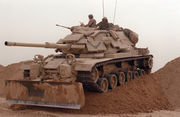
Kuwait
The M60A1 RISE Passive of the U.S. Marines saw action during Operation Desert Storm in 1991, opposing Iraqi armor which included the T-54/T-59, T-55, T-62, Type 69, and T-72. The M60A1s were fitted with add-on explosive reactive armor (ERA) packages and supported the drive into Kuwait City where they were involved in a two day tank battle at the Kuwait airport with the loss of only one vehicle and no crew. They saw service with the United States Marine Corps, and the Saudi Arabian Army.
Other users
As of 2005, M60 variants are in service with Bahrain, Bosnia, Brazil, Egypt, Greece, Iran, Israel, Portugal, Spain, Turkey, Taiwan, Thailand and some other nations to varying degrees . Also, the US continues to have significant stockpiles of them waiting to be scrapped, sold-off, converted, or used as targets in weapons testing, although some vehicles that use the chassis are still in use. Most of those still used are much upgraded models. Pattons formed the basis for many 'new' tank designs, some using the chassis but with all-new turrets others using various upgrade packages.
Combat performance
Overall, the M60A1/A3s performed well against opposing tanks such as T-55s, T-62s, T-72s and Type 69s in various conflicts including the Yom Kippur war, Lebanon and the battle for the Kuwait airport that involved hundreds of tanks in a two day, all out battle with only one vehicle lost on the US side. The Marine Corps M60A1s had ERA that helped to protect them, and the Iraqi tank crews were not well trained and were using poorly maintained equipment. During the Yom Kippur War, the M60 tank proved effective versus T-54/55 and T-62 tanks. However, many Israeli M60s were destroyed by Egyptian troops armed with AT-3 Sagger anti-tank missiles. Most of these casualties were in the first few days following the Egyptian crossing of the Suez Canal. Once the Egyptian armor left the cover of the anti-air umbrella, it sustained heavy losses to the Israeli Air Force, before it was defeated by dug-in Israeli tanks in defensive positions outnumbering Egyptian tanks 2-1, on the 14 October.
In Israeli service, the type was regarded ambiguously. Asked for his opinion, a former Israeli tank commander who had served in M60s in 1982 commented tersely, "they burn."
There were also a number of prototype upgrades evaluated in the U.S., which were passed over in favor of simply producing more M1 Abrams. Due to the end of the Cold War, surplus US Army M1 tanks were absorbed into the remaining USMC units allowing the Marine Corps to transition to an all M1 tank force at reduced cost.
The M60A3 participated in CAS trials with the F-16 in the 1980s.

During the 1991 Gulf War / Desert Storm at least one US Air Force unit was equipped with M60s. The 401st TFW (P), deployed to Doha, Qatar had two M60s intended for use by explosives ordnance disposal personnel. It was planned that using the MBTs would allow the EOD crews to remove unexploded ordnance from tarmac runway and taxiway surfaces with increased safety.[10]
M47 Patton tanks portrayed enemy tanks in the film "Battle of the Bulge", starring actor Robert Shaw and Henry Fonda; Spanish M48 Patton tanks were used as enemy tanks in the film "Patton", with actor George C. Scott as General Patton. The M60 series has appeared in many smaller roles in U.S. films made after World War II, and have become the stereotypical image of the Cold War U.S. tank. Ironically, in many American films Patton tanks are used to portray enemy tanks.
An M60A3 TTS was also involved in a police chase, when one was stolen by Shawn Nelson from an Army National Guard armory and taken on a rampage through San Diego, California. The driver was killed by police when he refused to surrender after the tank got stuck on concrete freeway dividers. News footage of this incident has been shown numerous times on World's Wildest Police Videos and other such programs.
Variants
- XM60/M60 - Bearing a strong familial resemblance to the M48, the M60 has a wedge shaped hull, three return rollers, and aluminum road wheels, features not found on previous M48s. Featured a turret with 105 mm M68 gun. Early versions did not have the commander's cupola.
- M60A1 - First variant to feature the distinctive "needle-nose" long nosed turret, along with better armor protection and improved hydraulics.
- M60A1 AOS - Add-On Stabilization, introduced in 1972 for the M68 gun.
- M60A1 RISE - Reliability Improvements for Selected Equipment, featured improvements of almost all the basic systems including an upgraded engine design that allowed easier access to components to allow removing the engine pack in less time and a new track type, T142, that helped reduce wear and improve track life.
- M60A1 RISE Passive - RISE, but with a smaller infra-red/white light capable search-light and passive night vision equipment. USMC M60A1 RISE Passives were outfitted with explosive reactive armor (ERA) in the late 1980s.
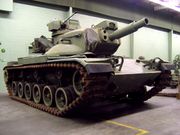
- M60A1E1 - Developmental test vehicles fitted with the 152 mm M162 gun-missile launchers.
- M60A1E2/M60A2 - Turret design finalized, giving the distinctive "starship" look. A variant was tested with a remote controlled 20 mm cannon as well.
- M60A1E3 - prototype, M60A1E2 fitted with 105 mm gun.
- M60A1E4 - Experimental type with remote control weapons.
- M60A3 - M60A1 fitted with a laser rangefinder, M21 solid state ballistic computer, and a crosswind sensor.
-
- M60A3 TTS - Tank Thermal Sight; M60A3s fitted with the AN/VSG-2 thermal sight.
- M60 Super/AX - Uparmored versions with minor improvements. Main version awas also featured no optical rangefinder.
- M60-2000/120S - M60/Abrams hybrid vehicle developed by General Dynamics Land Division. Not adopted by the United States military.
Specialized

- M60A1 AVLB - Armored Vehicle Launched Bridge, 60-foot (18 m) scissors bridge on M60A1 chassis.
- M60 AVLM - Armored Vehicle Launched MICLIC (Mine-Clearing Line Charge), modified AVLB with up to 2 MICLIC on M60 chassis.
- M60 Panther - M60 modified into a remotely controlled mine clearing tank.
- M728 CEV - M60A1-based Combat Engineer Vehicle fitted with a folding A-frame crane and winch attached to the front of the turret, and an M135 165mm demolition gun. Commonly fitted with the D7 bulldozer blade, or a mine-clearing equipment.
- M728A1 - Upgraded version of the M728 CEV.
Additional equipment:
- M9 - Bulldozer and earthmoving equipment for the M60.
International
- M60T - highly upgraded version of the M60A1 which is designed for the MBT modernization program of the Turkish Army. It features a new 120mm smoothbore gun, electric stabilization system, new fire control system, and new armor package.[11][12][13] M60T is also known as Sabra Mk.III.
- E-60
- E-60 - basically unmodified main production M60
- E-60A - basically unmodified M60A1
- E-60A Dozer - version with M9 bulldozer kit installed
- E-60B - basically unmodified M60A3
- Egyptian variants - M60A3 tanks in Egyptian service are upgraded with an improved diesel engine of 1,080 hp (810 kW) output, modern fire control & ballistics computers, infrared devices, modern laser range-finders, and added armor including reactive armor & better suspension. A further conversion to the M60A3 is scheduled between 2009 and 2012 to about 1000 tanks out of the current fleet of 1700, to replace the current turret with the M1A1 turret with a major uparmoring of the chassis and replace the transmission and suspension systems with a better one to suit the added weight of the tank. Armor plating will be covering the front, back and the side skirts. A German 1,500 hp (1,100 kW) diesel engine will be replacing the current one, and the main armament will be the 120 mm smooth bore found on the M1A1. This will eventually increase the weight of the tank to 65 tons.
- VLPD 26/70E - Spanish Army bridgelayer based on the M60 with "Leguan bridge system".
- Israeli variants - Many of the Israeli M60's have been upgraded with additional reactive or passive armor, drastically improving their armor protection. These uparmored versions are called Magach 6 / Magach 7.
- M60 Phoenix-Jordanian upgrade,being carried out by King Abdullah II Design And Development Bureau.[14] Upgrade includes shoot-on-move capabilities,increased firepower (with RUAG 120mm smoothbore gun) and armor protection scheme upgrade.
Operators

Current
 Afghanistan - 13 M60A3 donated by Greece (may receive a further 50 units)
Afghanistan - 13 M60A3 donated by Greece (may receive a further 50 units)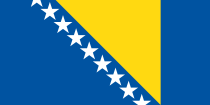 Bosnia and Herzegovina - 45 M60A3
Bosnia and Herzegovina - 45 M60A3 Bahrain, - 180 M60A3
Bahrain, - 180 M60A3 Brazil - 91 M60A3 TTS [15]
Brazil - 91 M60A3 TTS [15] Egypt - 2,300 M60A3
Egypt - 2,300 M60A3 Iran - 150 M60A1[16]
Iran - 150 M60A1[16] Israel - 711 Magach 6 Archuv and Magach 6 Archuv 2, 111 Magach 7 (to be increased by 74 before 2010).[17]
Israel - 711 Magach 6 Archuv and Magach 6 Archuv 2, 111 Magach 7 (to be increased by 74 before 2010).[17] Jordan - 250
Jordan - 250 Lebanon - 66 [18] A3 series, first 10 arrived on 22 May 2009 [19]
Lebanon - 66 [18] A3 series, first 10 arrived on 22 May 2009 [19] Morocco - 560 M60A3TTS
Morocco - 560 M60A3TTS Oman - 73
Oman - 73 Portugal - 100 M (to be retired)
Portugal - 100 M (to be retired) Saudi Arabia - 450 M60A1 and M60A3
Saudi Arabia - 450 M60A1 and M60A3 Spain - 16 M60A3TTS (only the Infantería de Marina)
Spain - 16 M60A3TTS (only the Infantería de Marina) Sudan - 20
Sudan - 20 Republic of China (Taiwan) - 450 M60A3 TTS[20]
Republic of China (Taiwan) - 450 M60A3 TTS[20] Thailand - 178 M60A3 Ex-U.S. Army
Thailand - 178 M60A3 Ex-U.S. Army Tunisia - 84
Tunisia - 84 Turkey - 925 M60A3TTS/M60A1 RISE-Passive
Turkey - 925 M60A3TTS/M60A1 RISE-Passive Yemen - 240
Yemen - 240
Former
 Austria
Austria Greece Retired from service in June 2009 with some 13 units transferred to Afghanistan while the remainder are to be sold for scrap.
Greece Retired from service in June 2009 with some 13 units transferred to Afghanistan while the remainder are to be sold for scrap. Italy
Italy United States Not in active service, some in reserve/storage.
United States Not in active service, some in reserve/storage. Ethiopia
Ethiopia
See also
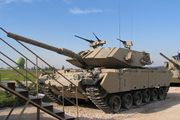
- M46 Patton
- M47 Patton
- M48 Patton
- M88 Recovery Vehicle - An armored recovery variant based on the M48 Patton/M60 Series tanks chassis and part of the automotive component.
- List of armoured fighting vehicles
- M103 heavy tank
- M1 Abrams
- G-numbers (SNL G292)
- Gun data computer
References
Notes
- ↑ 1.0 1.1 1.2 1.3 1.4 1.5 1.6 1.7 1.8 1.9 Foss, p. 166
- ↑ Hunnicutt
- ↑ Hunnicutt p. 165
- ↑ Hunnicutt pp. 6, 408
- ↑ Hunnicutt p. 157
- ↑ Hunnicutt/Firepower p. 181
- ↑ 7.0 7.1 "M60 Patton Main Battle Tank (USA)". Historyofwar.org. http://www.historyofwar.org/articles/weapons_m60patton.html. Retrieved 2010-03-26.
- ↑ 8.0 8.1 "Development and History of the M-60 tank". Patton Mania. http://www.patton-mania.com/M60_Patton/m60_patton.html.
- ↑ Development and History of the M-60 tank
- ↑ The Gulf War with the 401TFW/614TFS Lucky Devils
- ↑ Turkish Defence Industry Products M60 T
- ↑ M60 Tank Modernization Project
- ↑ Jane's Defence Weekly - June 06, 2007
- ↑ "Projects - Phoenix M60 Upgrade". KADDB. http://www.kaddb.com/static/project2.shtm. Retrieved 2010-03-26.
- ↑ Army Equipment - Brazil
- ↑ John Pike (2009-02-13). "Iranian Ground Forces Equipment". Globalsecurity.org. http://www.globalsecurity.org/military/world/iran/ground-equipment.htm. Retrieved 2010-03-26.
- ↑ Army Equipment - Israel
- ↑ "واشنطن تزوّد لبنان أسلحة ثقيلة قبل استحقاق حزيران" (in Arabic). Annahar Newspaper. April 09, 2009. http://www.lebanese-forces.com/ar/artde.asp?newsid=43196. Retrieved 2009-04-09.
- ↑ "Heavy U.S. Military Aid to Lebanon Arrives ahead of Elections". Naharnet Newsdesk. April 09, 2009. http://www.naharnet.com/domino/tn/NewsDesk.nsf/Lebanon/C4E6544B51A01293C2257593001BCF28?OpenDocument. Retrieved 2009-04-09.
- ↑ Army Equipment - Taiwan
Bibliography
- Foss, Chris (2005). Jane's armour and artillery : 2005-2006. Jane's Information Group. ISBN 9780710626868.
- Hunnicutt, R. P. (1984). Patton: A History of the American Main Battle Tank. Volume 1. Novato: Presidio Press. ISBN 9780891412304.
External links
- M60A3 Main Battle Tank Variant Details
- AFV Database: 105 mm Gun Tank M60
- Patton-Mania
- MilitaryImages.Net: M60 Series
